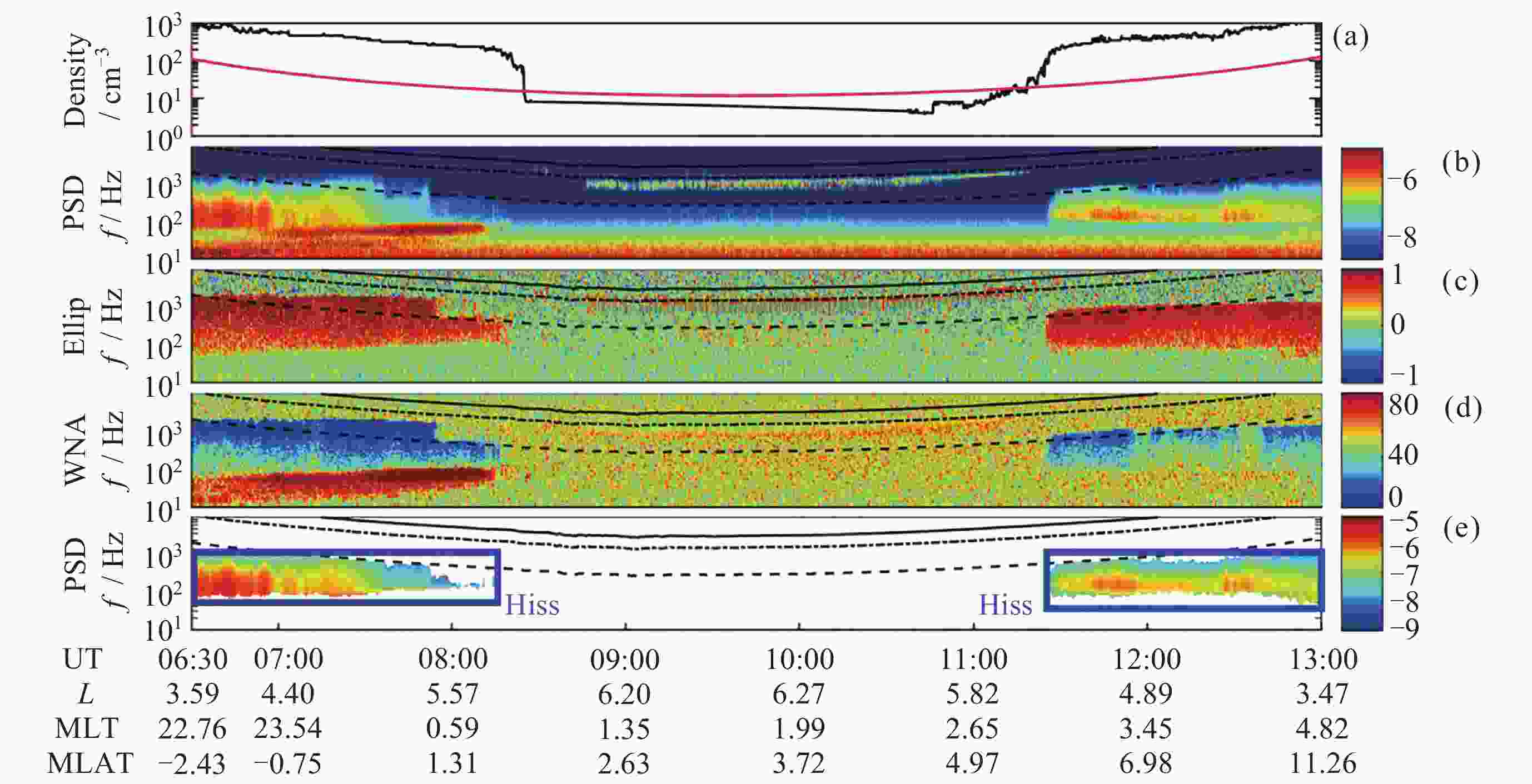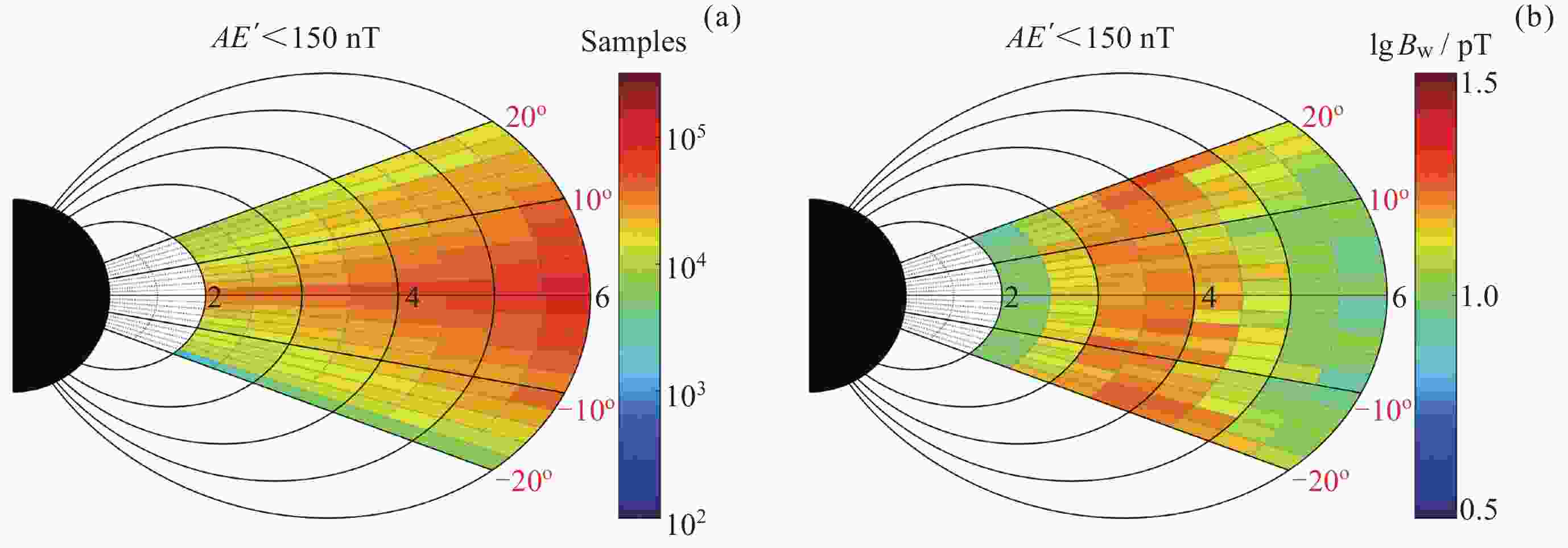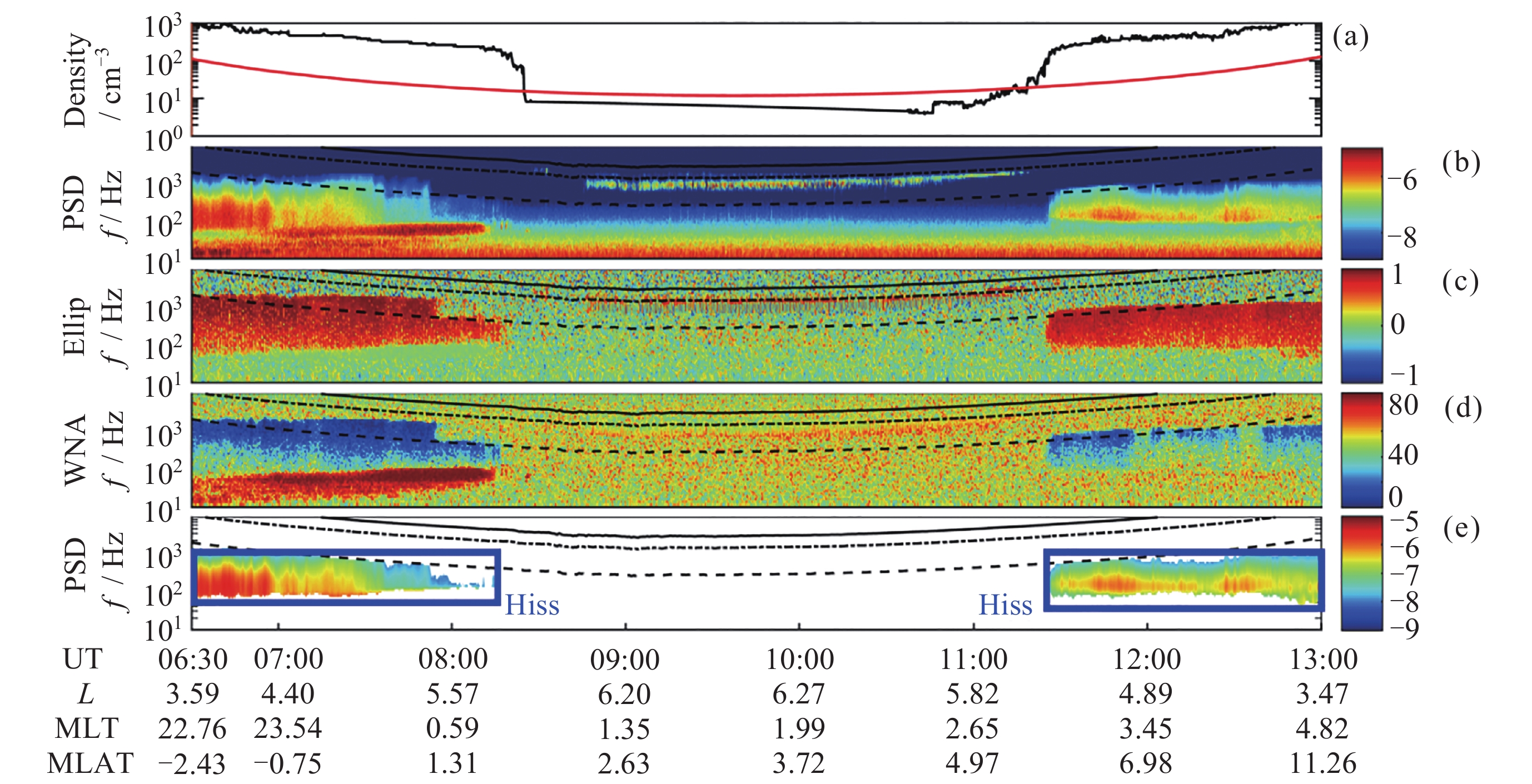Influence of Solar Wind Dynamic Pressure on Hiss Distribution Based on Van Allen Probe Observations
-
摘要: 哨声波作为常见的等离子体波动, 对于磁层内能量电子的加速和损失起着重要作用. 已有统计研究表明, 地磁活动对哨声波的分布具有显著影响, 但是关于太阳风活动对其的影响多以事件报道为主. 本文使用范艾伦卫星5年的数据进行统计, 在排除亚暴注入的影响之后, 对等离子体层内嘶声在不同太阳风动压下的分布进行研究. 结果表明随着太阳风动压的增强, 30~200 Hz和200~500 Hz的嘶声振幅出现了减弱, 与太阳风动压的变化呈负相关. 与频率较低的嘶声相反, 500~1000 Hz以及1000~2500 Hz的嘶声振幅与太阳风动压的变化则是呈现正相关的趋势. 此外, 嘶声在磁纬上的分布没有明显的峰值, 这表明观测到的嘶声大部分都不是本地激发的. 而不同频段的嘶声对于太阳风动压的不同响应则可能是由于源区在太阳风动压增强时受到不同程度的影响所导致的. 研究嘶声对于太阳风变化的响应情况, 对于理解嘶声的起源与演化具有重要作用.Abstract: As a common plasma waves, whistler mode waves play a crucial role in the acceleration and scattering of energetic electrons in the magnetosphere. Numerous previous statistical studies have demonstrated that geomagnetic activities have a significant impact on the distribution of whistler waves. However, reports on the influence of solar wind activities on them are predominantly event-based. Five years of data from the Van Allen Probes were used for statistical analysis. After excluding the influence of substorm injections, the distribution of plasmaspheric hiss under different solar wind dynamic pressures were investigated. The results indicate that as the solar wind dynamic pressure intensifies, the amplitudes of hiss waves at 30~200 and 200~500 Hz exhibit a weakening trend and show a negative correlation with the change in solar wind dynamic pressure. In contrast to low frequency hiss, for hiss at 500~1000 Hz and 1000~2500 Hz, their amplitudes show a positive correlation trend with the change of solar wind. Additionally, there is no distinct peak in the distribution of hiss at magnetic latitudes, suggesting that most of the observed hiss is not locally excited. The different responses of hiss in different frequency bands to the solar wind dynamic pressure may be attributed to the fact that the source region is affected to varying degrees when the solar wind dynamic pressure increases. Studying the response of hiss to changes in the solar wind plays an important role in understanding the origin and evolution of hiss.
-
Key words:
- Space plasma /
- Plasmaspheric hiss /
- Solar wind dynamic pressure /
- Magnetic longitude
-
图 1 2013年2月28日06:30 UT-13:00 UT范艾伦探测器A的观测结果. (a)黑色曲线表示卫星观测的实际背景电子密度, 红色曲线表示由判定条件式(1)计算出来的密度. (b)卫星观测的磁场功率密度谱 (单位nT2· Hz–1). (c)卫星观测的波动极化谱. (d)观测的波法向角谱 [单位(°)]. (e)根据筛选条件判断之后挑选出来的嘶声波 (单位nT2· Hz–1). 在(b)~(e)中三条自上而下的实线、点虚线, 虚线分别表示1倍、0.5倍, 0.1倍的电子回旋频率
Figure 1. Observation results of the Van Allen Probe A from 06:30 UT to 13:00 UT on 28 February 2013. (a) The black curve represents the electron density observed by the satellite, and the red curve represents the density calculated by the judgment condition Eq.(1). (b) The magnetic spectral density observed by the satellite (unit nT2· Hz–1). (c) The wave polarization spectral observed by the satellite. (d) The observed wave normal angle [unit (°)]. (e) The hiss waves selected according to the selection conditions (unit nT2· Hz–1). (b)~(e) The solid lines, dotted-dashed lines, and dashed lines from top to bottom represent 1, 0.5, and 0.1 times the electron cyclotron frequency, respectively
图 3 在不同强度的Psw下嘶声波平均振幅的分布. 每0.5L×2λMLAT格点范围内计算一次平均振幅. 右侧色条表示对应太阳风条件下每个格点中嘶声波振幅, 右下角小图代表对应的样本点数量
Figure 3. Distribution of the average amplitude of hiss waves under different intensities of Psw. The average amplitude is calculated within each bin of 0.5L×2λMLAT. The colorbar on the right side of the figure indicates the amplitude of hiss waves in each bin under the corresponding solar wind conditions. The small plot in the lower right corner of each panel represents the number of samples
-
[1] BURTIS W J, HELLIWELL R A. Banded chorus-A new type of VLF radiation observed in the magnetosphere by OGO 1 and OGO 3[J]. Journal of Geophysical Research, 1969, 74(11): 3002-3010 doi: 10.1029/JA074i011p03002 [2] SANTOLÍK O, GURNETT D A, PICKETT J S, et al. Spatio-temporal structure of storm-time chorus[J]. Journal of Geophysical Research: Space Physics, 2003, 108(A7): 1278 [3] LI H M, YUAN Z G, WANG D D, et al. Statistical characteristics of potentially chorus-driven energetic electron precipitation from POES observations[J]. Journal of Geophysical Research: Space Physics, 2016, 121(10): 9531-9546 doi: 10.1002/2016JA023101 [4] TANG R, SUMMERS D, DENG X. Effects of cold electron number density variation on whistler-mode wave growth[J]. Annales Geophysicae, 2014, 32(7): 889-898 doi: 10.5194/angeo-32-889-2014 [5] TANG R X, SUMMERS D. Dependence of whistler mode chorus wave generation on the maximum linear growth rate[J]. Journal of Geophysical Research: Space Physics, 2019, 124(6): 4114-4124 doi: 10.1029/2018JA026413 [6] ZHANG H, LI Q, TANG R X, et al. Background parameter effects on linear–nonlinear chorus wave growth in the planetary magnetosphere[J]. The Astrophysical Journal, 2020, 904(2): 105 doi: 10.3847/1538-4357/abbeee [7] SUMMERS D, TANG R X. Influence of kappa distributions on the whistler mode instability[J]. Journal of Geophysical Research: Space Physics, 2021, 126(1): e2020JA028276 doi: 10.1029/2020JA028276 [8] LI H M, FU T X, TANG R X, et al. Statistical study and corresponding evolution of plasmaspheric plumes under different levels of geomagnetic storms[J]. Annales Geophysicae, 2022, 40(2): 167-177 doi: 10.5194/angeo-40-167-2022 [9] SUMMERS D, NI B B, MEREDITH N P, et al. Electron scattering by whistler-mode ELF hiss in plasmaspheric plumes[J]. Journal of Geophysical Research: Space Physics, 2008, 113(A4): A04219 [10] THORNE R M, SMITH E J, BURTON R K, et al. Plasmaspheric hiss[J]. Journal of Geophysical Research, 1973, 78(10): 1581-1596 doi: 10.1029/JA078i010p01581 [11] BORTNIK J, THORNE R M, MEREDITH N P. The unexpected origin of plasmaspheric hiss from discrete chorus emissions[J]. Nature, 2008, 452(7183): 62-66 doi: 10.1038/nature06741 [12] SUMMERS D, OMURA Y, NAKAMURA S, et al. Fine structure of plasmaspheric hiss[J]. Journal of Geophysical Research: Space Physics, 2014, 119(11): 9134-9149 doi: 10.1002/2014JA020437 [13] GREEN J L, BOARDSEN S, GARCIA L, et al. On the origin of whistler mode radiation in the plasmasphere[J]. Journal of Geophysical Research: Space Physics, 2005, 110(A3): A03201 [14] BORTNIK J, LI W, THORNE R M, et al. An observation linking the origin of plasmaspheric hiss to discrete chorus emissions[J]. Science, 2009, 324(5928): 775-778 doi: 10.1126/science.1171273 [15] LI H M, YUAN Z G, YU X D, et al. The enhancement of cosmic radio noise absorption due to hiss-driven energetic electron precipitation during substorms[J]. Journal of Geophysical Research: Space Physics, 2015, 120(7): 5393-5407 doi: 10.1002/2015JA021113 [16] NISHIMURA Y, BORTNIK J, LI W, et al. Identifying the driver of pulsating aurora[J]. Science, 2010, 330(6000): 81-84 doi: 10.1126/science.1193186 [17] THORNE R M, NI B B, TAO X, et al. Scattering by chorus waves as the dominant cause of diffuse auroral precipitation[J]. Nature, 2010, 467(7318): 943-946 doi: 10.1038/nature09467 [18] ZHU H, SHPRITS Y Y, SPASOJEVIC M, et al. New hiss and chorus waves diffusion coefficient parameterizations from the Van Allen Probes and their effect on long-term relativistic electron radiation-belt VERB simulations[J]. Journal of Atmospheric and Solar-Terrestrial Physics, 2019, 193: 105090 doi: 10.1016/j.jastp.2019.105090 [19] HORNE R B, THORNE R M. Potential waves for relativistic electron scattering and stochastic acceleration during magnetic storms[J]. Geophysical Research Letters, 1998, 25(15): 3011-3014 doi: 10.1029/98GL01002 [20] LI W, THORNE R M, MEREDITH N P, et al. Evaluation of whistler mode chorus amplification during an injection event observed on CRRES[J]. Journal of Geophysical Research: Space Physics, 2008, 113(A9): A09210 [21] LI W, THORNE R M, ANGELOPOULOS V, et al. Global distribution of whistler-mode chorus waves observed on the THEMIS spacecraft[J]. Geophysical Research Letters, 2009, 36(9): L09104 [22] MEREDITH N P, HORNE R B, SICARD-PIET A, et al. Global model of lower band and upper band chorus from multiple satellite observations[J]. Journal of Geophysical Research: Space Physics, 2012, 117(A10): A10225 [23] BORTNIK J, THORNE R M, MEREDITH N P. Modeling the propagation characteristics of chorus using CRRES suprathermal electron fluxes[J]. Journal of Geophysical Research: Space Physics, 2007, 112(A8): A08204 [24] LI W, THORNE R M, BORTNIK J, et al. Global distributions of suprathermal electrons observed on THEMIS and potential mechanisms for access into the plasmasphere[J]. Journal of Geophysical Research: Space Physics, 2010, 115(A12): A00J10 [25] MEREDITH N P, HORNE R B, THORNE R M, et al. Substorm dependence of plasmaspheric hiss[J]. Journal of Geophysical Research: Space Physics, 2004, 109(A6): A06209 [26] KIM K C, LEE D Y, SHPRITS Y. Dependence of plasmaspheric hiss on solar wind parameters and geomagnetic activity and modeling of its global distribution[J]. Journal of Geophysical Research: Space Physics, 2015, 120(2): 1153-1167 doi: 10.1002/2014JA020687 [27] KEIKA K, SPASOJEVIC M, LI W, et al. PENGUIn/AGO and THEMIS conjugate observations of whistler mode chorus waves in the dayside uniform zone under steady solar wind and quiet geomagnetic conditions[J]. Journal of Geophysical Research: Space Physics, 2012, 117(A7): A07212 [28] LI W, THORNE R M, ANGELOPOULOS V, et al. Evaluation of whistler-mode chorus intensification on the nightside during an injection event observed on the THEMIS spacecraft[J]. Journal of Geophysical Research: Space Physics, 2009, 114(A1): A00C14 [29] Yu X D, YUAN Z Z, LI H M, et al. Response of banded whistler mode waves to the enhancement of solar wind dynamic pressure in the inner Earth’s magnetosphere[J]. Geophysical Research Letters, 2018, 45(17): 8755-8763 doi: 10.1029/2018GL078849 [30] LIU N G, SU Z P, GAO Z L, et al. Simultaneous disappearances of plasmaspheric hiss, exohiss, and chorus waves triggered by a sudden decrease in solar wind dynamic pressure[J]. Geophysical Research Letters, 2017, 44(1): 52-61 doi: 10.1002/2016GL071987 [31] SU Z P, ZHU H, XIAO F L, et al. Disappearance of plasmaspheric hiss following interplanetary shock[J]. Geophysical Research Letters, 2015, 42(9): 3129-3140 doi: 10.1002/2015GL063906 [32] MAUK B H, FOX N J, KANEKAL S G, et al. Science objectives and rationale for the radiation belt storm probes mission[M]//FOX N, BURCH J L. The Van Allen Probes Mission. Boston: Springer, 2012 [33] KLETZING C A, KURTH W S, ACUNA M, et al. The electric and magnetic field instrument suite and integrated science (EMFISIS) on RBSP[J]. Space Science Reviews, 2013, 179(1/2/3/4): 127-181 [34] KURTH W S, DE PASCUALE S, FADEN J B, et al. Electron densities inferred from plasma wave spectra obtained by the Waves instrument on Van Allen Probes[J]. Journal of Geophysical Research: Space Physics, 2015, 120(2): 904-914 doi: 10.1002/2014JA020857 [35] WANG J L, LI L Y, YU J. Statistical relationship between exohiss waves and plasmaspheric hiss[J]. Geophysical Research Letters, 2020, 47(5): e2020GL087023 doi: 10.1029/2020GL087023 [36] MEREDITH N P, BORTNIK J, HORNE R B, et al. Statistical investigation of the frequency dependence of the chorus source mechanism of plasmaspheric hiss[J]. Geophysical Research Letters, 2021, 48(6): e2021GL092725 doi: 10.1029/2021GL092725 [37] MALASPINA D M, JAYNES A N, HOSPODARSKY G, et al. Statistical properties of low-frequency plasmaspheric hiss[J]. Journal of Geophysical Research: Space Physics, 2017, 122(8): 8340-8352 doi: 10.1002/2017JA024328 [38] NI B B, LI W, THORNE R M, et al. Resonant scattering of energetic electrons by unusual low-frequency hiss[J]. Geophysical Research Letters, 2014, 41(6): 1854-1861 doi: 10.1002/2014GL059389 [39] SHI R, LI W, MA Q L, et al. Systematic evaluation of low-frequency hiss and energetic electron injections[J]. Journal of Geophysical Research: Space Physics, 2017, 122(10): 10263-10274 [40] ZHU H, LIU X, CHEN L J. Triggered plasmaspheric hiss: Rising tone structures[J]. Geophysical Research Letters, 2019, 46(10): 5034-5044 doi: 10.1029/2019GL082688 [41] TANG R X, YUAN A, LI H M, et al. Influence of solar wind dynamic pressure on distribution of whistler mode waves based on Van Allen Probe observations[J]. Journal of Geophysical Research: Space Physics, 2023, 128(4): e2022JA031181 doi: 10.1029/2022JA031181 -
-





 袁安 男, 1998年8月出生于江西省新余市, 现为南昌大学空间科学与技术研究院博士研究生, 主要研究方向为磁层中哨声波的波粒相互作用. E-mail:
袁安 男, 1998年8月出生于江西省新余市, 现为南昌大学空间科学与技术研究院博士研究生, 主要研究方向为磁层中哨声波的波粒相互作用. E-mail: 

 下载:
下载:






